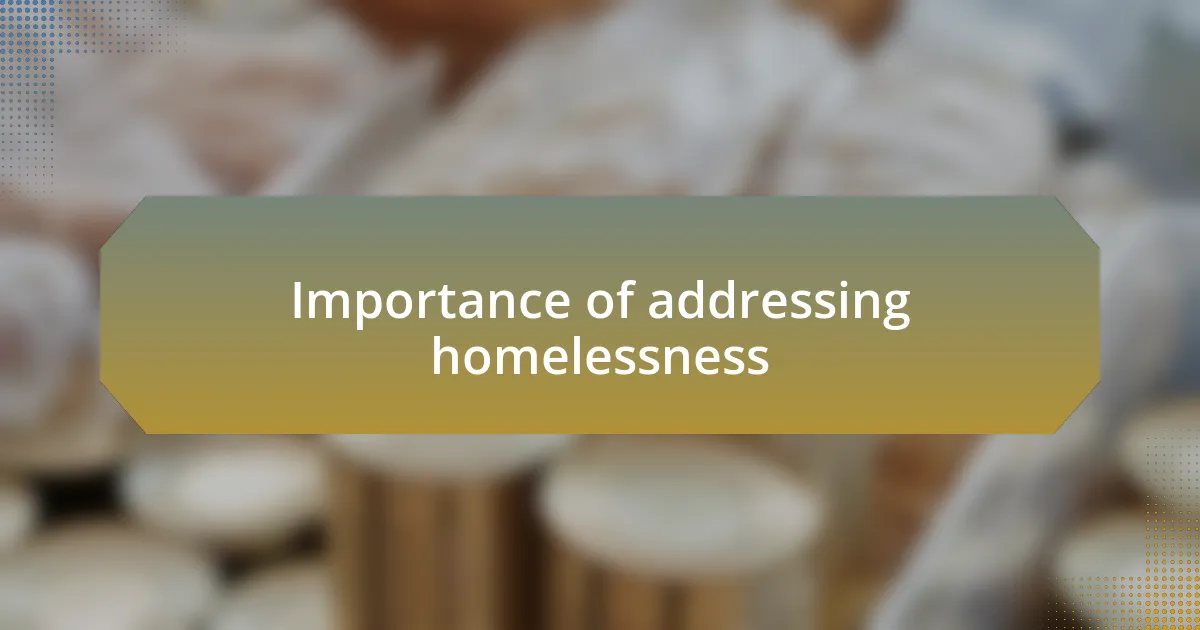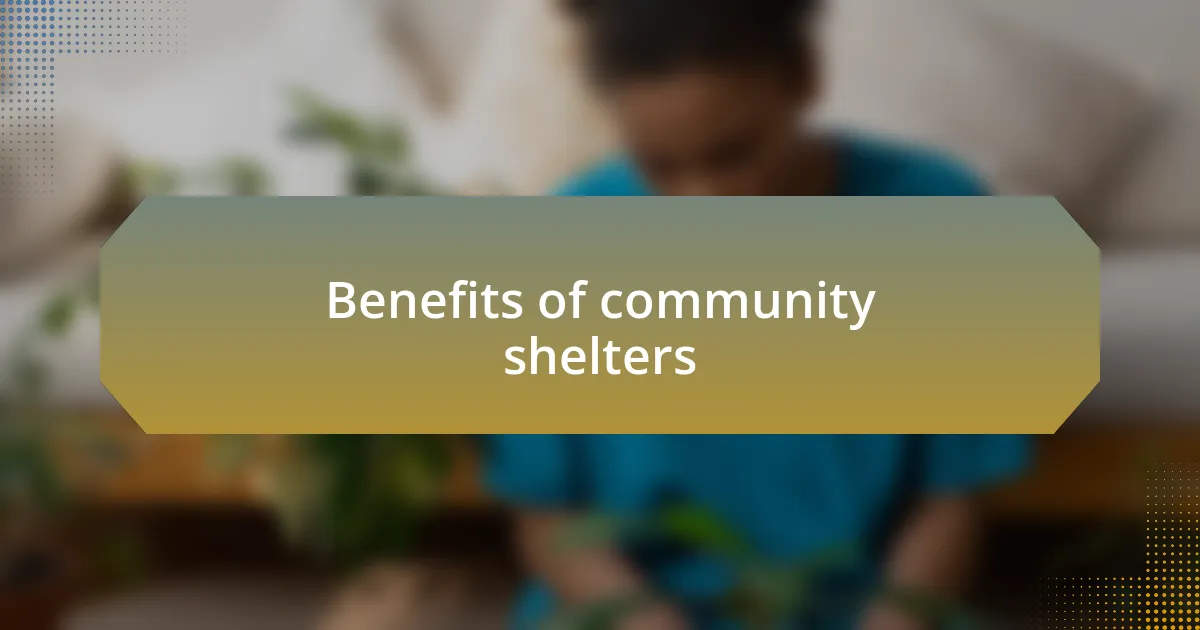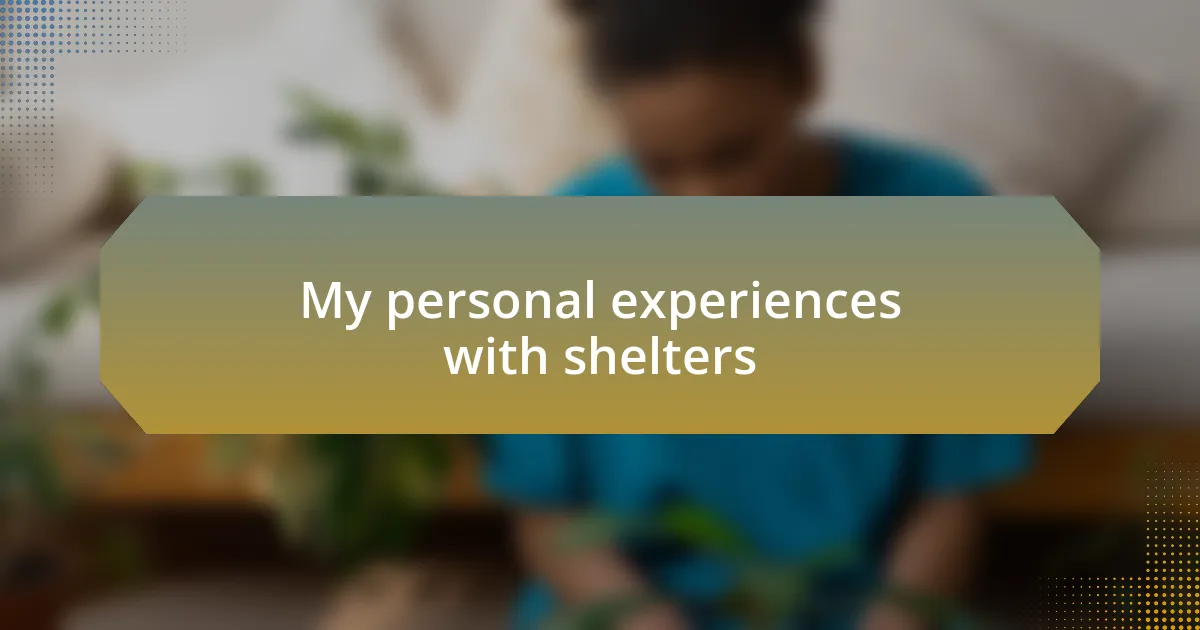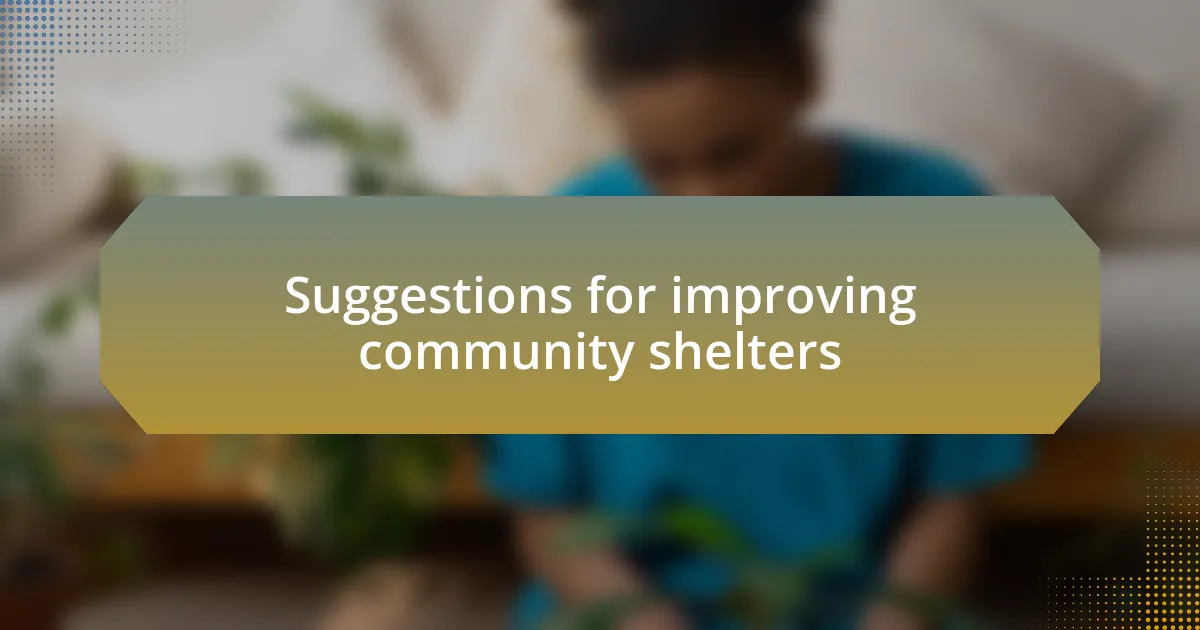Key takeaways:
- Community shelters provide essential services beyond just a place to sleep, such as meals, clothing, and job training, helping individuals transition to stable living.
- Addressing homelessness benefits the entire community by enhancing safety, cohesion, and economic stability, showcasing the interconnectedness of all community members.
- Effective homelessness charities combine immediate aid with long-term solutions, emphasizing the importance of funding and community support in breaking the cycle of homelessness.
- Personalized services, a welcoming environment, and interagency collaboration can significantly improve the effectiveness of community shelters, fostering a sense of belonging and access to resources.

Understanding community shelters
Community shelters serve as vital lifelines for individuals facing homelessness. They provide not only a safe place to sleep but also crucial resources like meals, clothing, and sometimes even job training. I remember visiting a local shelter where I spoke with a young mother who simply needed a stable environment for her children. Her story highlighted the importance of community support in transforming lives.
When you think about community shelters, what comes to your mind? For many, it might evoke images of cramped spaces or long lines. However, my experience has shown me that these shelters are often warm and welcoming spaces filled with compassionate staff and volunteers. They cultivate a sense of belonging that many guests have been missing for a long time.
It’s essential to understand that community shelters aren’t just about providing a bed for the night. They often act as a bridge to a better future. I once met a man who began his journey at a shelter after losing everything. The support he received there was instrumental in helping him transition into stable housing and find employment. Such success stories remind us that with the right resources and a supportive community, change is always possible.

Importance of addressing homelessness
Addressing homelessness is crucial for a thriving community. I remember visiting a neighborhood where a sudden increase in homelessness affected not just the individuals, but the entire community’s sense of safety and cohesion. It made me realize that when we don’t act, everyone feels the ripple effect.
Think about it—what happens to families when people in their community struggle with basic needs? I once spoke with a local business owner worried that homelessness was driving away customers. This concern underscores how interconnected we all are. By supporting those in need, we strengthen our community as a whole.
Moreover, addressing homelessness can lead to significant economic benefits. I recall learning about programs that not only help individuals secure stable housing but also reduce costs associated with emergency services. Investing in community shelters can be a life-changing choice for everyone involved—like turning a frustrating problem into a shared solution that benefits all.

Overview of homelessness charity
Homelessness charity organizations play a vital role in creating pathways for individuals to regain stability and dignity. I remember volunteering at a shelter where I met a woman named Sarah. Her story of resilience and the transformation she experienced was truly inspiring. Supporting such charities is not just about providing food and shelter; it’s about fostering hope and rebuilding lives.
In my experience, effective homelessness charities combine immediate relief with long-term solutions. I once attended a workshop focused on job training for individuals experiencing homelessness. It struck me how providing skills and opportunities can ignite a sense of purpose and belonging. How often do we overlook the potential hidden within our communities? Helping people tap into that potential is a gift we give back to society.
Funding is crucial for these charities, and I often find myself reflecting on where the resources come from. During a fundraising event, I had the chance to hear from a shelter director about the impact of community support. Each donation, no matter how small, contributes to a larger mission of breaking the cycle of homelessness. It’s incredibly empowering to see how our collective efforts can spark real change in the lives of those who need it most.

Types of community shelters
Community shelters come in various forms, each tailored to meet the unique needs of individuals experiencing homelessness. There are emergency shelters, which provide immediate, short-term accommodations and essential services. I recall a day spent at one of these shelters, where the urgency in the air struck me; people arriving with little but the clothes on their backs, seeking refuge and safety.
Transitional housing is another key type of community shelter, offering a bridge from homelessness to stability. These shelters often provide longer-term stays, allowing individuals to regroup and work towards permanent housing solutions. I remember speaking to a man who had lived in transitional housing for several months. His stories of progress toward self-sufficiency and independence were filled with hope yet grounded in the reality of slow progress. Can you imagine the revelation of having a space to call one’s own after facing uncertainty?
Finally, supportive housing focuses on offering individuals not just shelter, but also access to essential resources like counseling and job training. This holistic approach resonates deeply with me, as it embodies the idea that having a roof over one’s head is just the beginning. I once had a conversation with a woman who spoke about how the skills she gained through a shelter program transformed her life. The blend of security and support touched my heart and highlighted the profound impact such shelters can have in fostering genuine change.

Benefits of community shelters
Community shelters are invaluable resources that offer immediate relief and safety to those facing homelessness. I remember volunteering at a shelter where I met a young mother with two children. Seeing her gratitude for the warm meals and a safe place to sleep really brought home the idea that these shelters provide more than just a roof; they offer a much-needed sense of security during a profoundly difficult time.
One of the most significant benefits of community shelters is their ability to foster connection and belonging. I often think about a group of long-term residents I encountered during my time at a transitional housing facility. They formed a close-knit community, supporting each other through life’s challenges. Can you imagine how empowering it must feel to know you’re not alone in your struggles? These social bonds can be crucial for emotional well-being and recovery.
Moreover, community shelters often serve as gateways to essential services. For instance, at one shelter, I witnessed individuals accessing job training, healthcare, and counseling right on-site. I spoke with a man who credited the shelter’s outreach programs with helping him find stable employment. His words still resonate with me: “It was not just a place to stay; it was a place to rebuild my life.” This shows that shelters can be transformative, guiding individuals toward sustainable pathways out of homelessness.

My personal experiences with shelters
During my time visiting shelters, I was struck by the warmth and resilience of the people I met. I remember talking to an elderly gentleman who shared his story over an afternoon coffee. Each word reflected a lifetime of experiences, and I found myself wondering, how often do we overlook the wisdom of those around us simply because of their circumstances?
One evening, I joined a community dinner at a local shelter where residents prepared meals together. I could feel the atmosphere of camaraderie, almost like a family reunion. Watching them laugh and support one another reminded me of the power of shared experiences. Have you ever felt that deep sense of connection when surrounded by people who truly understand your struggles?
Reflecting back on those experiences, I realize how much I learned from the residents. There was a woman I met who had recently lost her job and was using the shelter as a stepping stone to regain her independence. Her determination was palpable, and it made me reflect on my own setbacks. What if I faced such challenges? The strength I witnessed there not only inspired me but also reinforced my belief in the potential for change within each individual.

Suggestions for improving community shelters
One effective way to enhance community shelters is by incorporating more personalized services. I remember visiting a shelter that offered skill-building workshops—from cooking to resume writing. These sessions not only empowered individuals but also fostered a sense of purpose. How often do we think about the skills that could help people regain their footing?
Another suggestion is to create a welcoming environment that feels more like home. I once witnessed a shelter transform its common area with art and greenery, which made a significant difference in residents’ morale. It made me think: wouldn’t it be incredible if all shelters had spaces where people could personalize their surroundings, even just a little?
Finally, I believe interagency collaboration could amplify the support available to shelter residents. During my interactions, I saw the challenges faced by those who needed mental health services but didn’t know where to turn. Imagine if shelters partnered with local health providers, making resources readily available on-site. Wouldn’t it be life-changing for someone to access help in a familiar and supportive environment?